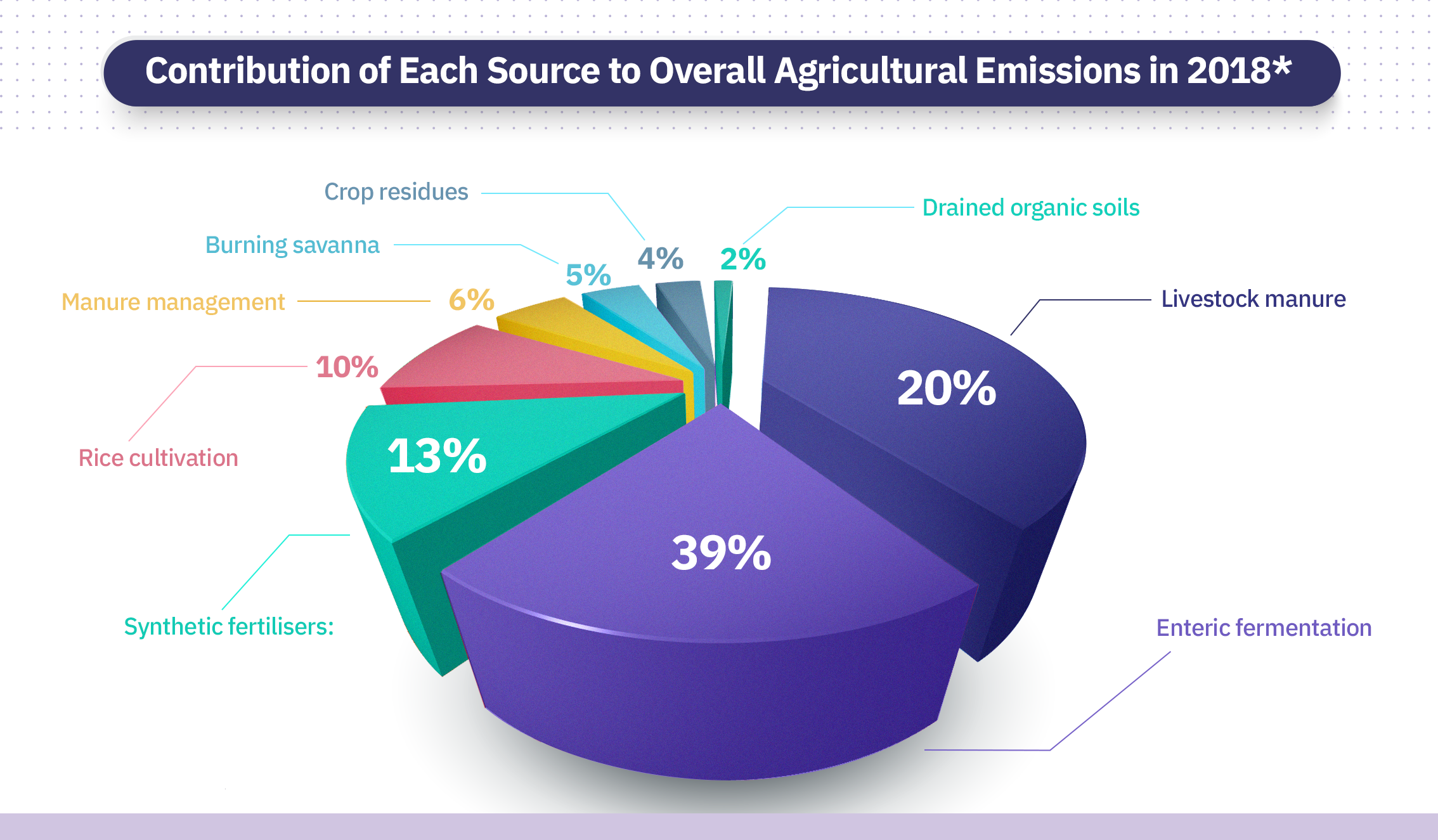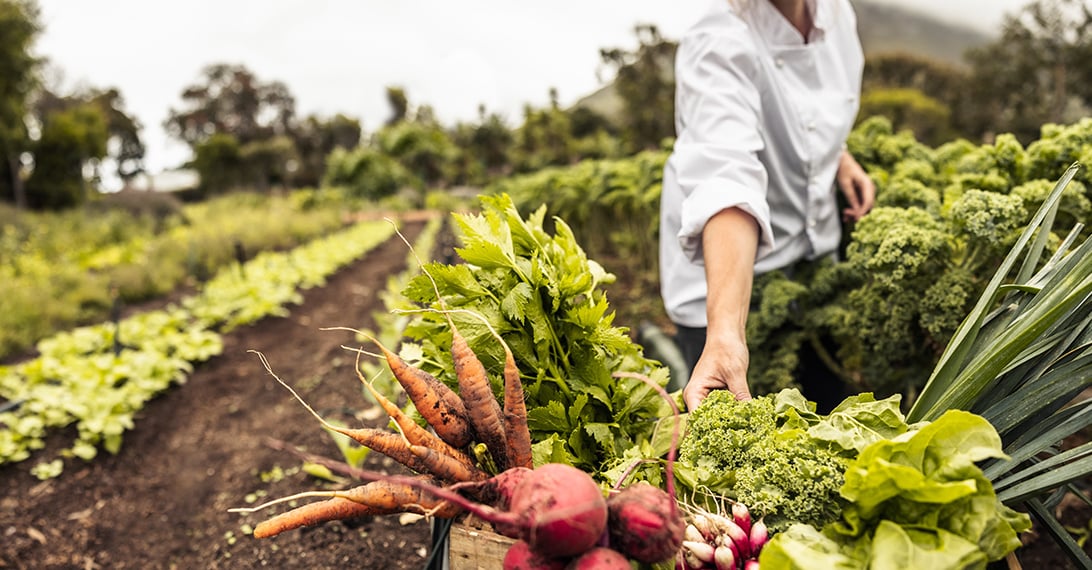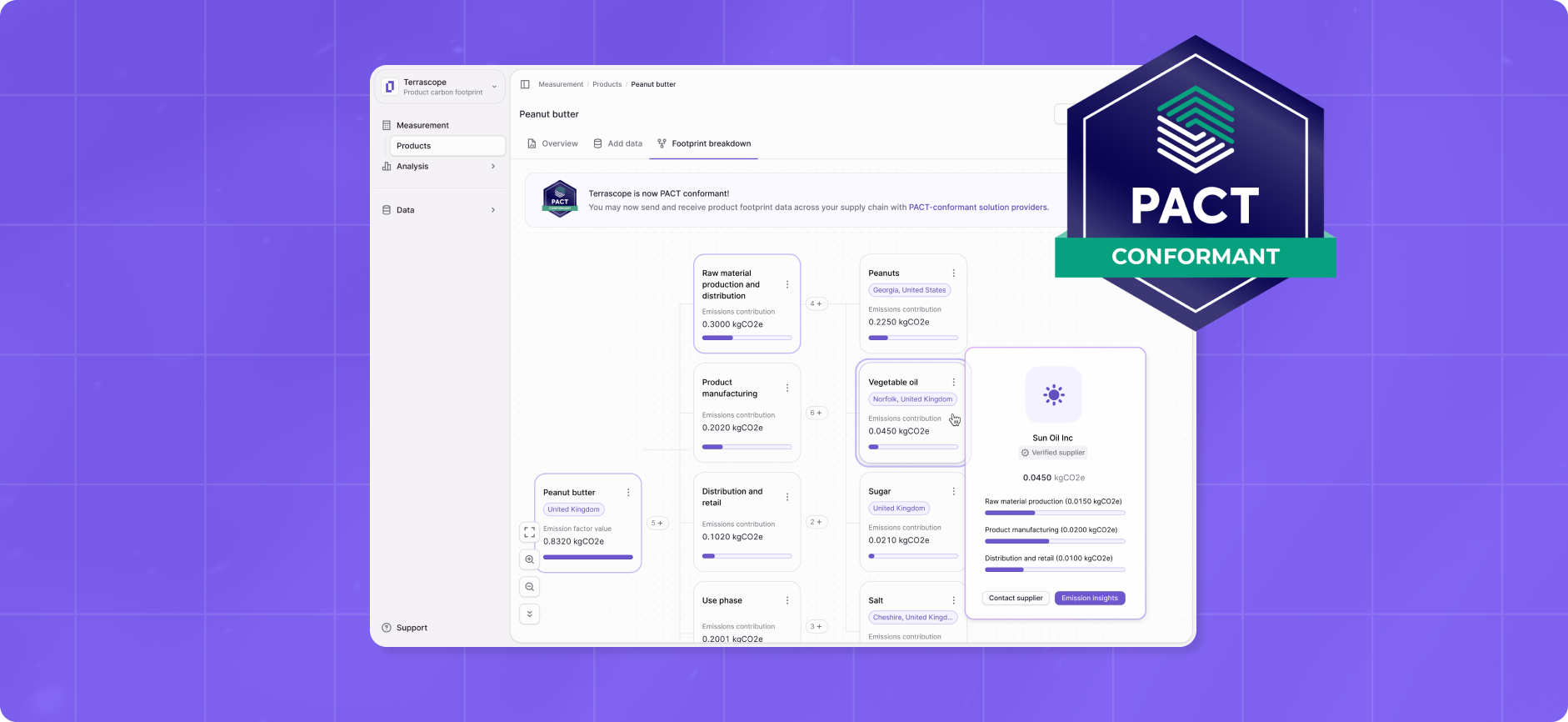Summary
- Agricultural greenhouse gas emissions contribute around 34% of global carbon dioxide equivalent emissions, mainly from livestock, soil management, and fossil fuel use, necessitating urgent action for climate mitigation.
- Implementing sustainable practices, such as improved feed efficiency and site-specific nutrient management, can significantly reduce emissions in the agri-food sector, with potential reductions of 12% by 2030.
- Government policies and incentives can significantly influence sustainable agriculture, as demonstrated by the successful Montreal Protocol for ozone layer restoration, highlighting the effectiveness of coordinated international climate efforts.
Agricultural greenhouse emissions (GHGs) from crop cultivation and animal husbandry contribute heavily to climate change. Terrascope recently collaborated with PwC, Rabobank and Temasek on a report, “The Asia Food Challenge: Decarbonising the Agri-Food Value Chain in Asia”, which revealed that agri-food is a significant source of emissions globally, accounting for approximately 34% of all carbon dioxide equivalent emissions.
Introduction
Although the agriculture sector is a significant contributor to greenhouse gas emissions globally, it also presents a significant opportunity to mitigate climate change. For instance, there is a potential to slash carbon dioxide equivalent emissions in the Asian agri-food sector by 12% by 2030 if all stakeholders take action – this is equivalent to the emissions from the entire global aviation industry in 2022. To mitigate climate change, it is important to understand and address these emissions sustainably and productively.
The agriculture sector offers this way forward by adopting regenerative practices that promote diversity over monocultures, offering holistic instead of reductionist solutions, and working with nature instead of competing against it. Read on to understand the major sources of agriculture greenhouse gas emissions and how we can build a more sustainable food supply chain.
In-Depth Exploration of 3 Major Sources of Agricultural Greenhouse Gas Emissions and Their Solutions
Agriculture and greenhouse gas emissions go hand in hand as the need for cheap, rapidly growing produce has increased over the years. This is likely due to the exponential increase in the global middle class among other factors; the global middle class increased over 3 times from about 500 million in 2000 to about 1.7 billion in mid-2020. Agricultural industrialisation began after World War II to address global hunger and optimise the food supply chain. As such, agricultural activities have contributed heavily towards the release of GHGs into the atmosphere, which influence climate change.
1. Livestock emissions
- From enteric fermentation in ruminant livestock: Ruminant livestock, such as cattle, produce methane (CH3) during their digestive processes, also known as enteric fermentation A potent GHG, methane (CH3), has 30 times the global warming potential (GWP) of carbon dioxide. The increasing number of livestock farms worldwide has led to a more than 10 percent increase in annual methane emissions from cattle alone. In 2021, global methane emissions from enteric fermentation in ruminants were estimated at roughly 74 million metric tons.
- From improper manure management: Handling livestock manure properly is essential to avoid methane and nitrous oxide emissions. Nitrous oxide (N2O) is a particularly potent GHG with a GWP 273 times greater than carbon dioxide, surpassing even methane in its impact. The anaerobic conditions present during manure decomposition contribute to the emission of these two GHGs. Nitrous oxide is produced both directly and indirectly during manure storage and treatment before it is used for feed, construction, or fuel purposes.
- Solutions to reduce GHG emissions from livestock: By adopting sustainable livestock practices, we can curb agricultural greenhouse gas emissions through:
- Improved feed efficiency: Enhancing livestock feed to reduce methane emissions during digestion can be an effective approach to fight climate change. Supplement concentration in the feed, improved forage quality, and the use of additives can help reduce methane emissions.
- Manure management strategies: The implementation of anaerobic digestion systems in the process of manure management at farms can help mitigate the environmental impact of the natural decomposition process of manure. This is achieved by capturing methane for energy production and burning it to produce electricity, power garbage trucks, and heat buildings among other things.
2. Soil management practices
- From fertiliser use: Nitrous oxide arises primarily from the application of nitrogen-based fertilisers. The microbial processes of nitrification and denitrification in the soil lead to nitrous oxide emissions. The use of fertilisers with high nitrogen content for crops inevitably increases the soil’s nitrogen levels, which inadvertently promotes nitrous oxide emissions.
- From crop residue management: Crop residue, or leftover harvesting by-product, needs to be managed well, especially as its decomposition releases methane and nitrous oxide. In some cases, crop residue is even burnt, clearing the field quickly, but at immense cost to the environment. Poor management practices often exacerbate such emissions and contribute to climate change.
- Solutions to reduce GHG emissions from soil management practices: Simple and efficient soil management, along with precision agriculture, can go a long way in fighting climate change. The following are some ways to reduce GHG emissions from farms:
- Site-specific Nutrient Management (SSNM): Site-specific Nutrient Management (SSNM) is a dynamic approach to fertiliser application, tailored to location and season, ensuring optimal usage. For example, a Terrascope client has successfully integrated SSNM into the Sustainable Rice Platform (SRP) training program to advance sustainable rice farming practices. By providing training to farmers aimed at reducing synthetic fertiliser usage and optimising fertiliser balance, they observed significant results. A comparison between farmers receiving two to three years of training versus one year showed remarkable reductions in societal costs of water pollution (14%) and GHG emissions (21%) per tonne of rice produced.
- Cover cropping: Soil health can be dramatically improved by integrating cover crops into farming operations, which consequently lowers the need for synthetic fertilisers.
- Conservation tillage practices: Conservation tillage, defined as the practice of leaving crop residue to cover at least 30% or more of the growing area, involves the reduction of soil disturbance and retention of organic matter in soil. Minimal soil disturbance has the effect of reducing CO2 and N2O emissions and improves the sequestration of carbon and nitrogen in the soil.
3. Fossil fuel use and land-use changes
- From mechanised agriculture: Industrialised agriculture has increased the productivity of farming operations by multiple folds but at a hefty price tag. Carbon dioxide (CO2) is released when these machines are run using fossil fuels, among other GHG emissions. Apart from this, extensive use of agricultural machinery - which often runs on fossil fuels - contributes to increased GHG emissions. Heavily mechanised agriculture practices can also cause more permanent damage to the soil through methods such as soil compaction.
- From deforestation to agriculture: Deforestation for agriculture is a major driver of land-use change emissions, releasing stored carbon in trees into the atmosphere. The expansion of agricultural frontiers, fueled by the demand for food and biofuel production, has led to extensive deforestation in regions like the Amazon rainforest and Southeast Asia, exacerbating the global climate crisis. Researchers have found that mean temperatures have increased steadily between 1981 and 2020 in the Amazon-Cerrado transition zone, with a substantial rise of nearly 1°C in just the past 20 years. The data also shows that rainfall has decreased by 0.08 millimetres (0.003 inches) per day per decade, while the frequency of dry days rose by 1.5 days per decade in the region.
Researchers have previously raised concerns about large portions of the Amazon irreversibly turning into savannah-like landscapes as temperatures continue to rise. This transformation could result in the loss of vital habitats for species and may even impact agricultural productivity in the region, posing risks to food security, livelihoods, and the economy. - From feed production: Global demand for animal products has driven the expansion of feedstock agriculture such as soybeans and corn. Such cultivation for livestock necessitates extensive land use and often involves converting diverse ecosystems into monoculture fields. This not only diminishes biodiversity but also releases stored greenhouse gases into the atmosphere, accelerating climate change.
- Solutions to reduce GHG emissions from fossil fuel use and land-use changes:
- Adoption of solar and wind energy in agriculture: The use of windmills or solar panels to generate clean energy for farming operations reduces the reliance on carbon-intensive fuels, which can help in reducing the carbon footprint of the agriculture sector. Renewable energy can pave the way towards a sustainable future.
- Transition to electric or alternative-fuel-powered machinery: Replacing carbon-intensive tools and machines with electric-powered or renewable energy-powered equipment, for example, can significantly reduce agriculture carbon emissions of farming by 44–70%, depending on the type of the farm.
- Agroforestry: Agroforestry, which refers to the process of integrating trees into agricultural landscapes not only enhances soil health but also leads to carbon sequestration. Beyond providing shade, windbreaks, and habitat for biodiversity, trees play a crucial role in enhancing soil health and promoting carbon sequestration. Their root systems stabilise soil, preventing erosion and improving its structure and fertility. Moreover, trees absorb carbon dioxide during photosynthesis, storing carbon in their biomass and the soil through decomposed organic matter.
- Forest conservation and restoration initiatives: Conserving the forests can help preserve the biodiversity and carbon sinks in the environment. Reforestation is an excellent strategy to offset carbon emissions and mitigate the impact of deforestation on agriculture. Over time, reforestation efforts can help in restoring ecosystems to a certain extent, sustain biodiversity, and prevent soil degradation. Although reforestation is beneficial, conserving existing forests plays an important role in regulating the climate of the region.
Contribution of Each Source to Overall Agricultural Emissions

Here is the contribution of agricultural activities to total non-CO2 emissions in 2018 according to the Food and Agriculture Organisation (FAO):
- Enteric fermentation: 39%
- Livestock manure: 20%
- Synthetic fertilisers: 13%
- Rice cultivation: 10%
- Manure management: 6%
- Burning savanna: 5%
- Crop residues: 4%
- Drained organic soils: 2%
The Role of Government Policies and Incentives in Mitigating Agricultural GHG Emissions
Whether through regulations, fines, or wider programmes, governments can play a significant role in encouraging sustainable agriculture. Whilst they have had a mixed record involving climate regulation, they marshal far more resources than just businesses and can enforce environmental regulations. For example, the adoption of the Montreal Protocol on Substances that Deplete the Ozone Layer in 1987 helped in restoring the planet’s ozone layer, especially after it emerged that the ongoing use of chlorofluorocarbons (CFCs) - typically used in everyday household products such as air conditioners and refrigerators - were depleting the Earth’s protective ozone layer and increasing the level of ultraviolet radiation reaching our planet’s surface. A total of 197 countries backed the Protocol, which has had tremendous impact on bringing together national regulation, resulting in a forecasted restoration of the ozone layer to 1980 levels by the mid 21st century. The ability to bring together governments in pursuit of a wider goal emphasises the capability of supranational treaties to shepherd and align climate action.
The implementation of carbon taxes by governments helps regulate GHG emissions, penalise emissions beyond a set limit, and help keep emissions below the pre-set limits. Some examples of agricultural regulation created by governments include integrated crop-livestock-forest systems (ICLF), microfinancing, land use planning, and trade regulations. More such regulations incentivising emission reduction practices are anticipated in the future.
Conclusion
Agriculture greenhouse gas emissions are a complex problem, which requires a collaborative effort from consumers, policymakers, and businesses. All of these stakeholders play an important role in the food supply chain, but policymakers and businesses play outsized roles in the enforcement and implementation of sustainable practices. By creating incentives for the agricultural sector to incorporate efficient decarbonisation systems, a more sustainable and resilient agricultural system can be created.



